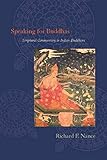Speaking for Buddhas : Scriptural Commentary in Indian Buddhism / Richard Nance.
Material type: TextPublisher: New York, NY : Columbia University Press, [2011]Copyright date: ©2011Description: 1 online resource (312 p.) : 4 tablesContent type:
TextPublisher: New York, NY : Columbia University Press, [2011]Copyright date: ©2011Description: 1 online resource (312 p.) : 4 tablesContent type: - 9780231152303
- 9780231526678
- 294.385 23
- BQ1029.I42 N36 2012
- BQ1029.I42 N36 2015
- online - DeGruyter
- Issued also in print.
| Item type | Current library | Call number | URL | Status | Notes | Barcode | |
|---|---|---|---|---|---|---|---|
 eBook
eBook
|
Biblioteca "Angelicum" Pont. Univ. S.Tommaso d'Aquino Nuvola online | online - DeGruyter (Browse shelf(Opens below)) | Online access | Not for loan (Accesso limitato) | Accesso per gli utenti autorizzati / Access for authorized users | (dgr)9780231526678 |
Browsing Biblioteca "Angelicum" Pont. Univ. S.Tommaso d'Aquino shelves, Shelving location: Nuvola online Close shelf browser (Hides shelf browser)

|

|

|

|

|

|

|
||
| online - DeGruyter Dying to Forget : Oil, Power, Palestine, and the Foundations of U.S. Policy in the Middle East / | online - DeGruyter Hindu Widow Marriage / | online - DeGruyter Religion, the Enlightenment, and the New Global Order / | online - DeGruyter Speaking for Buddhas : Scriptural Commentary in Indian Buddhism / | online - DeGruyter Spirals : The Whirled Image in Twentieth-Century Literature and Art / | online - DeGruyter The Other Cold War / | online - DeGruyter The Birth of Conservative Judaism : Solomon Schechter's Disciples and the Creation of an American Religious Movement / |
Frontmatter -- Contents -- Acknowledgments -- Introduction -- ONE. Models of Speaking: Buddhas and Monks -- TWO. Models of Instruction: Preachers Perfect and Imperfect -- THREE. Models of Argument: Epistemology and Interpretation -- FOUR. Models of Explication: Commentarial Guides -- Conclusion -- APPENDIX A The Vyākhyāyukti , Book I -- APPENDIX B. The Abhidharmasamuccayabhāṣya (Excerpt) -- APPENDIX C. The * Vivaraṇasaṃgrahaṇī -- Notes -- Bibliography -- Index of Texts -- Index
restricted access online access with authorization star
http://purl.org/coar/access_right/c_16ec
Buddhist intellectual discourse owes its development to a dynamic interplay between primary source materials and subsequent interpretation, yet scholarship on Indian Buddhism has long neglected to privilege one crucial series of texts. Commentaries on Buddhist scriptures, particularly the sutras, offer rich insights into the complex relationship between Buddhist intellectual practices and the norms that informand are informed bythem. Evaluating these commentaries in detail for the first time, Richard F. Nance revisitsand rewrites-the critical history of Buddhist thought, including its unique conception of doctrinal transmission.Attributed to such luminaries as Nagarjuna, Vasubandhu, Dignaga, and Santideva, scriptural commentaries have long played an important role in the monastic and philosophical life of Indian Buddhism. Nance reads these texts against the social and cultural conditions of their making, establishing a solid historical basis for the interpretation of key beliefs and doctrines. He also underscores areas of contention, in which scholars debate what it means to speak for, and as, a Buddha. Throughout these texts, Buddhist commentators struggle to deduce and characterize the speech of Buddhas and teach others how to convey and interpret its meaning. At the same time, they demonstrate the fundamental dilemma of trying to speak on behalf of Buddhas. Nance also investigates the notion of "right speech" as articulated by Buddhist texts and follows ideas about teaching as imagined through the common figure of a Buddhist preacher. He notes the use of epistemological concepts in scriptural interpretation and the protocols guiding the composition of scriptural commentary, and provides translations of three commentarial guides to better clarify the normative assumptions organizing these works.
Issued also in print.
Mode of access: Internet via World Wide Web.
In English.
Description based on online resource; title from PDF title page (publisher's Web site, viewed 02. Mrz 2022)


